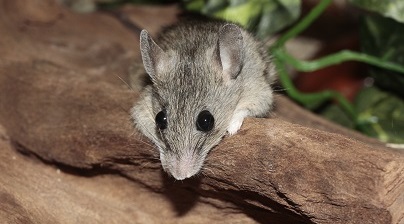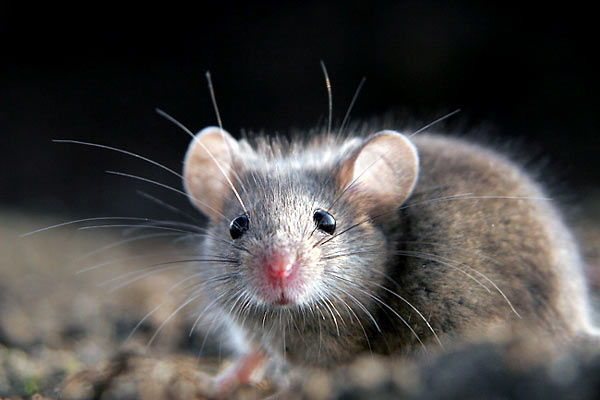Knowing the house mouse to catch it better
The house mouse (Mus Musculus) is generally grey to brownish in colour. Its adult size, including tail, varies from 10 to 15 cm. Depending on the species, the adult mouse weighs between 10 and 30 g. Its
life expectancy varies from 1 to 2 years. This mammal is classified as a “rodent”, which means that it has to gnaw constantly to wear out its incisors, which are constantly growing, just like rabbits. It is a
fast and agile animal that climbs easily on all porous surfaces. Its size and weight allow it to sneak into the smallest corners. Mice are omnivorous, which means that they can eat a variety of foods such as
cereals, bread, fruit, rice, pasta, chocolate, biscuits, vegetables, vegetation and many other things such as your pets’ food. The daily nutritional requirements of a mouse are 15% of its weight, the percentage
of its water requirements is the same.


Where the house mouse lives :
Mice can live in the city as well as in the country because, like all rodents classified as pests, they are extremely adaptable. In the countryside, you will find them in barns, food storage areas and in crop plots. At home, whether you live in the country or in town, you will find them in the following places: attics, unfinished attics, behind plasterboard walls, in false ceilings, …. In fact, this rodent can nest anywhere in your home as long as there are insulation materials such as glass or rock wool, polystyrene and others. This means that you can also find them in your oil boiler, as this too has its own insulation. Or even in the insulation of gas cookers or refrigerators. In fact you can’t live in your home without running the risk of encountering this adorable squatter.
House mouse lifestyle :
The mouse lives in a hierarchical community system governed by dominant males, a community that will thrive as long as nesting and feeding conditions are met.
Breeding of house mouse :
A mouse can reproduce from the 6th week of its existence. Gestation lasts about 20 days and each litter can give birth to up to 10 pups, which can become independent as early as the 5th week of life. A female can reproduce within a few days of giving birth to her young.
Nuisance from house mouse :
As you will have noticed from reading this information page or from your own experience following an infestation the mouse can cause countless nuisances. Mice are small, agile, prolific, move around and nest in places virtually inaccessible to humans. They feed on little and everything. Its biggest problem, especially with humans, is that its two pairs of incisors are constantly growing and to live properly it must constantly gnaw to wear them out.
The combination of these different factors leads to the following nuisances:
- Damage to your home and its insulation,
- Financial costs of restoring your home,
- Energy costs due to the deterioration of your insulation,
- Damage to your electrical equipment and household appliances,
- High risk of electrical shorts and fires,
- Food loss due to nibbling of your food,
- Soiling of your food and your environment due to its urine
- Health risks following the accidental consumption of food soiled by its urine, – Loss of crops for farms,
- Financial losses for food storage companies,
- Financial losses for food distribution shops,
- Transmission of serious diseases such as Leptospirosis and Salmonellosis,
- Possibility of causing asthma attacks and various allergies.
For all these reasons we strongly advise you to solve your infestation problem by trusting one of the [Pest Control service providers] present on our directory or to supply yourself with [materials and products] available from our British partner.
Methods of Operation Mouse Infestation Treatments
There are 3 different ways to treat a mouse infestation:
I, Mechanical treatments :
Mechanical treatment consists of using non-toxic traps that have an immediate visual effect.
A, Glue boards
Glue boards are the most commonly used modern materials. They should be at least 25 x 12 cm for maximum effect and should be placed every 5 meters and always along a wall. A plate with the above dimensions can capture 3-5 mice in a few days. Humanly speaking this is not the best method as the animals captured either die of exhaustion after a few days or suffocate if their snouts are caught in the glue.
B, Mouse traps or creels
A tried and tested method that is easy to place along the path of rodents. The trick is to find the right bait that will attract your mice and to “adjust” the sensitivity of your mouse traps so that they are triggered at the right moment. Contrary to what many people believe, mice that are caught by the traps sometimes take several minutes to die in agony.
The use of traps also requires some experience in adjusting the sensitivity of the locking system. If you have the opportunity, make sure that mice attracted by your bait do not move your traps, which would cause an unwanted closure of your traps.
II, Chemical Treatment
Chemical treatment is the treatment with poisons. For maximum effectiveness it is advisable not to use grain as the toxic concentration is only found on the grain shell which greatly limits its effectiveness. Waterproof blocks have the advantage of being more effective because the toxic concentration is in the “mass” of the bait. The only disadvantage is that they are not very attractive to rodents.
The product par excellence is “Fresh Paste” (if it is less than 6 months old) because not only is the toxic concentration in the “mass” of the product used, but if it is fresh it is very palatable because it is perfectly scented to attract your mice.
Whatever the type of product used, it must be placed in baiting stations, secured with a key, in order to avoid any undesirable incidents of poisoning of non-target animals and children. Bait stations should be placed along rodent paths at a distance of about 4 meters from each other. For your treatment to be effective you should check your bait stations once a week and refill them with product until consumption has ceased.

